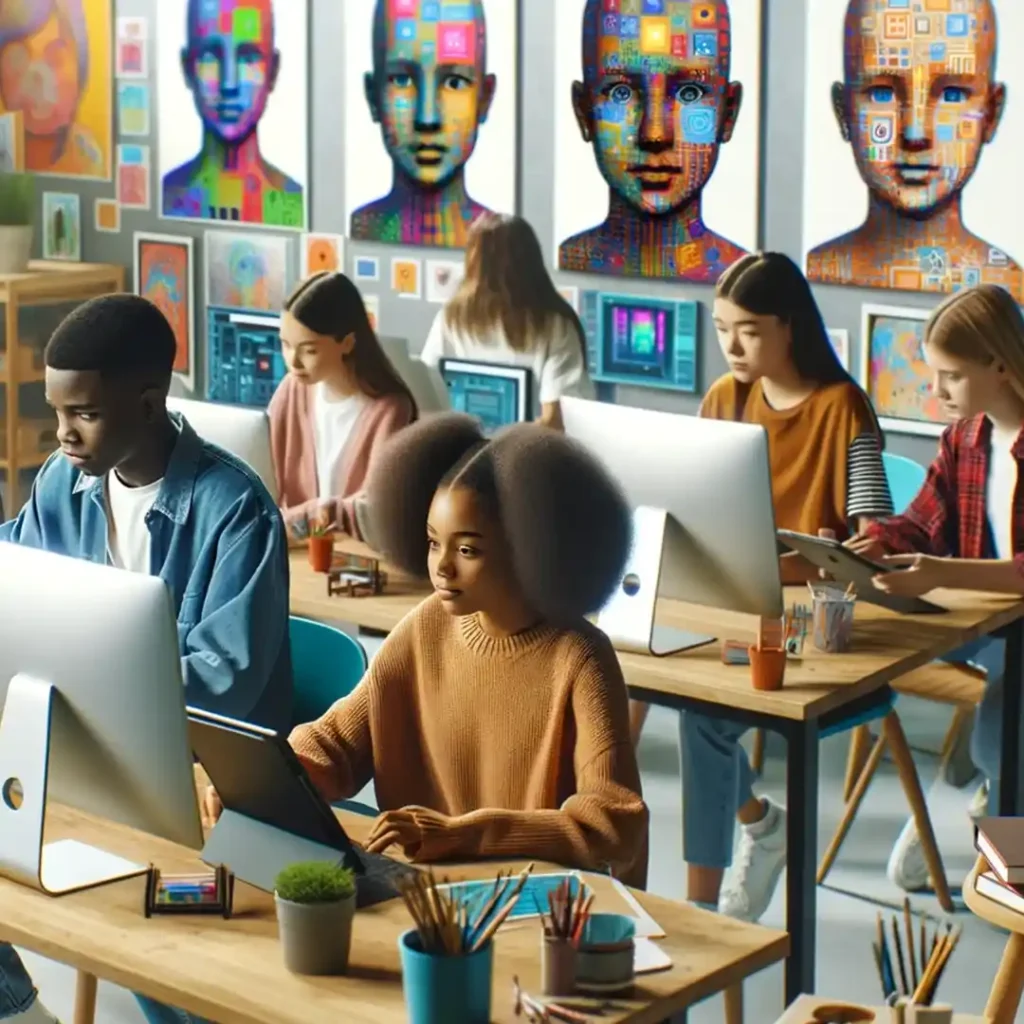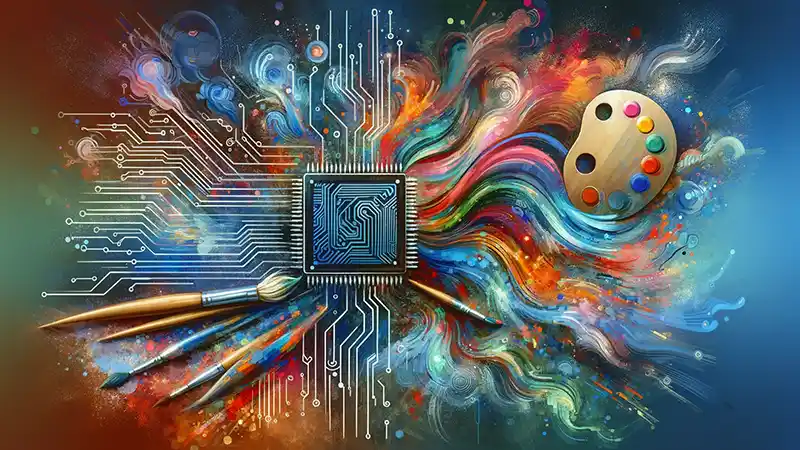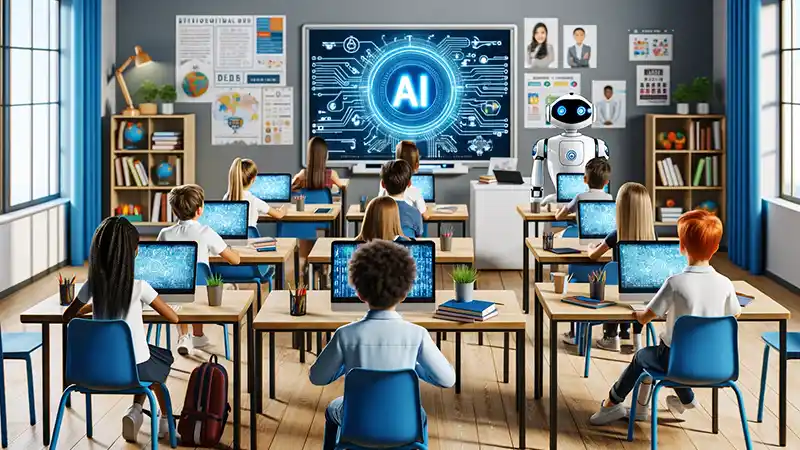The fusion of Artificial Intelligence (AI) and art marks a revolutionary shift in the landscape of art education. This intersection is not just about leveraging technology for convenience; it’s about opening new avenues for creativity and expression. The integration of AI in art classes has grown significantly, driven by the technology’s ability to enhance educational experiences and expand the boundaries of traditional art forms.
AI’s growing relevance in art education stems from its capacity to individualize learning and push the frontiers of artistic creation. It offers tools and platforms that redefine the way art is taught, learned, and created, making art more accessible, inclusive, and innovative. This article delves into ten transformative ways AI is being used in art classes today.
1. AI as a Tool for Personalized Learning
One of the most significant impacts of AI in art education is its ability to cater to the unique learning styles and artistic preferences of each student. AI-powered tools can analyze a student’s interaction with digital content, tailoring the learning pathway to suit their pace and style. This personalized approach ensures that students are not just passive recipients of information but active participants in their learning journey.
For example, AI-driven platforms can suggest customized tutorials and resources based on a student’s progress and interests. A student struggling with digital painting techniques might receive recommendations for specific skill-building exercises, while another showing an interest in 3D modeling could be directed to advanced sculpting tutorials. Such AI tools provide a learning experience that is not only personalized but also adaptive, constantly evolving to meet the needs of each student.
Furthermore, AI in art education opens the door to new forms of artistic expression. From AI-assisted design software that suggests color palettes and layouts to algorithms that help create complex digital artworks, the possibilities are endless. These tools not only enhance the learning experience but also inspire students to explore new artistic horizons, blending traditional art techniques with cutting-edge technology.
For step-by-step instructions on creating individual lesson plans with ease, click here.
2. Enhancing Creative Processes with AI Algorithms

AI algorithms are increasingly becoming integral to the creative processes in art education. These algorithms can assist artists in various ways, from generating initial ideas to refining final pieces. AI’s capability to process vast amounts of data and recognize patterns can inspire artists to explore new creative territories.
For instance, AI algorithms can analyze historical art styles and techniques, providing artists with novel ideas that fuse classical and contemporary elements. This can lead to the creation of artworks that are both familiar and strikingly original. A case in point is the use of AI to generate digital landscapes that blend the styles of famous painters, offering students a unique perspective on how different art styles can be combined.
Another fascinating development is AI’s ability to create art independently. Some AI programs can generate original artworks based on certain parameters set by the user. These artworks are not just random compositions but are often sophisticated and aesthetically pleasing, showcasing AI’s growing role as a creative partner in art.
3. Using AI for Artistic Collaboration
AI also plays a pivotal role in enhancing collaboration in the art world. It enables a seamless interaction between students and digital platforms, fostering an environment where ideas can be shared and developed collaboratively.
One way AI facilitates this is through cloud-based platforms where students can work on joint projects, share feedback, and collectively refine their artwork. These platforms can be integrated with AI tools that offer suggestions on improvements, layout changes, or even color scheme alterations, based on the collective input of the group.
Furthermore, AI is instrumental in fostering global artistic collaborations. Through AI-powered translation tools and culturally aware design suggestions, students from different parts of the world can work together on projects, overcoming language and cultural barriers. This not only enriches the learning experience but also prepares students for a globally interconnected art world.
4. AI-Driven Art Analysis and Critique
AI’s capability to analyze and critique art adds a new dimension to art education. With advanced image recognition and machine learning algorithms, AI tools can examine art styles, techniques, and even the intricacies of brushwork. These tools offer students insights that were previously accessible only through years of study or with the guidance of an experienced art critic.
For example, AI can compare a student’s work with a vast database of historical artworks, providing feedback on style, technique, and even suggesting artists with similar styles for further study. This feature is particularly beneficial in helping students understand where their work fits within the broader context of art history and contemporary trends.
Moreover, AI can offer constructive critiques of students’ artworks. By analyzing elements like composition, color balance, and form, AI can provide objective feedback, complementing the subjective critiques from human instructors. This dual approach ensures that students receive well-rounded feedback, essential for their artistic growth.
5. Interactive Art Experiences with AI
The integration of AI in art does not stop at creation and critique; it extends to how art is experienced. AI is at the forefront of creating interactive art installations that respond to and engage with viewers. These installations often use sensors and AI algorithms to change the artwork based on the viewer’s movements, sounds, or even physiological responses, creating a unique experience for each viewer.
Additionally, AI is making significant strides in the realms of Virtual Reality (VR) and Augmented Reality (AR). In art classes, VR can transport students to virtual art galleries or allow them to step inside a 3D rendering of historical artworks. AR, on the other hand, can overlay digital art onto the physical world, offering an immersive experience that blurs the line between reality and digital creation.
6. AI in Art History Education

AI technology has become a valuable asset in the teaching of art history, offering innovative ways to explore historical art movements and cultural contexts. AI-driven platforms can simulate art creation techniques from different eras, giving students an interactive and immersive understanding of historical artworks. For instance, AI can replicate the painting techniques of the Renaissance or Impressionist periods, allowing students to virtually ‘paint’ in these styles and better comprehend the artistic skills and methods of the past.
Moreover, AI can create virtual environments where students can explore digital recreations of historical sites or art galleries. This technology not only brings art history to life but also makes it more accessible, removing geographical and physical barriers to world-class museums and cultural sites.
7. Exploring New Art Forms Through AI
The advent of AI has led to the emergence of new art forms, such as generative art, where algorithms create artwork based on a set of rules or parameters defined by the artist. This form of art challenges traditional notions of creativity, as the AI can generate unexpected and complex patterns that may not be achievable by human hands alone.
In art classes, students can experiment with AI to create unique art pieces. This could involve using AI software to manipulate images, create 3D models, or even compose music. These exercises not only enhance students’ technical skills but also encourage them to think creatively about the role of technology in art.
The exploration of AI in creating new art forms is not just an exercise in technology; it’s a journey into the future of artistic expression. It prompts students to question and redefine the boundaries of art, exploring how machines can be used not just as tools but as collaborators in the creative process.
8. Classroom Management
In addition to enhancing the creative and educational aspects of art classes, AI can significantly streamline classroom management, allowing educators to devote more time and energy to instruction.
Assistance in Administrative Tasks: AI can handle a range of administrative tasks, from attendance tracking to grading assignments. For example, AI-powered systems can analyze and grade student artwork based on certain criteria, providing immediate feedback. This automation reduces the time teachers spend on routine tasks, enabling them to focus more on individual student guidance and creative exploration.
Organizing and Presenting Art Portfolios: AI tools can revolutionize how student art portfolios are created, organized, and presented. With AI software, students can digitally compile their artwork, which the system can then categorize based on style, technique, or other criteria. These digital portfolios can be easily shared with teachers, peers, or even external audiences, providing a platform for showcasing students’ artistic journey and growth.
Customized Learning Pathways and Assessment: AI can tailor learning pathways for each student, adapting to their progress and specific needs in art education. It can analyze a student’s performance over time and suggest areas for improvement, or new techniques to explore. This personalized approach ensures that students receive the most relevant and effective instruction, tailored to their individual learning journey.
Incorporating AI into classroom management and learning pathways not only streamlines administrative processes but also enhances the educational experience. It provides teachers with powerful tools to manage their classes more efficiently and offers students a more personalized and engaging learning environment. As AI continues to evolve, its potential to transform art education becomes increasingly evident, making it an invaluable asset for both teachers and students in the art classroom.
9. Real-Time Language Translation and Cultural Exchange in Art Classes

AI can play a pivotal role in promoting cultural exchange and understanding in art classes through real-time language translation and cultural insights. This application is particularly valuable in diverse classrooms or in settings where students are exposed to international art forms and practices.
Breaking Language Barriers in Art Education: AI-powered translation tools can instantly translate instructions, critiques, and discussions into multiple languages. This capability is invaluable in classrooms with non-native speakers, ensuring that all students can access and participate in the learning process equally. It fosters an inclusive environment where language is not a barrier to learning and creativity.
Facilitating Global Artistic Collaboration: AI translation tools enable students from different cultural backgrounds to collaborate on art projects. This could involve international virtual classrooms where students from various parts of the world work together, sharing and learning from each other’s artistic traditions and perspectives. AI aids in seamless communication, allowing students to exchange ideas and create art that reflects a fusion of diverse cultural influences.
Enhancing Understanding of Global Art Forms: AI can provide insights into cultural contexts and historical backgrounds of art from around the world. For instance, when studying a particular art movement or artist, AI can offer relevant cultural and historical data, helping students understand the artwork in a broader global context. This deepens students’ appreciation of the diversity and richness of global art forms.
10. Enhancing Visual Perception and Art Interpretation
AI technology offers groundbreaking possibilities in enhancing visual perception and art interpretation, making it an invaluable tool in art education.
Augmented Visual Learning Experiences: AI can be used to create augmented reality (AR) experiences that enrich visual learning. For instance, AR overlays can provide students with detailed insights into different art techniques, styles, and historical contexts directly on their artwork or in a gallery setting. This augmented visualization can help students better understand complex concepts and techniques.
Enhanced Interpretation of Artworks: AI algorithms can analyze and interpret artworks, providing students with deeper insights into the composition, color theory, and symbolism used. This could involve AI systems that, when presented with an artwork, offer an analysis of its style, historical influences, and potential meanings. Such tools can be instrumental in teaching art critique and appreciation, offering perspectives that might not be immediately apparent to the human eye.
Personalized Visual Discovery Journeys: AI can guide students on personalized discovery journeys through art history and contemporary art. Based on a student’s interests and interaction with different artworks, AI can recommend similar artists, styles, or art movements to explore. This personalization makes the study of art history more engaging and relevant to each student, encouraging exploration and independent learning.
Interactive 3D Art Creation and Visualization: With AI, students can venture into 3D art creation, which involves using AI tools to design and visualize three-dimensional artworks. This application is particularly useful in sculpture and installation art classes, where students can create and modify their designs in a virtual space before executing them physically.
Incorporating AI into the aspects of visual perception and art interpretation transforms how students perceive and interact with art.
Conclusion
The transformative impact of Artificial Intelligence (AI) in art education is both profound and multifaceted. As we have explored, AI offers a wealth of tools and applications that significantly enhance the teaching and learning of art. From personalized learning experiences and creative process augmentation to global collaboration and augmented visual learning, AI is redefining the boundaries of what is possible in art education.
AI’s role in art classes goes beyond mere technological integration; it fosters a deeper engagement with art. It encourages a blend of creativity and innovation, allowing students to explore new horizons in artistic expression. AI’s capabilities in providing real-time language translation and cultural insights further expand the scope of art education, making it a more inclusive and globally interconnected experience.
For educators, the call to action is clear: Embrace AI not just as a novel tool, but as a transformative element in the art classroom. Integrating AI into art education does not diminish the value of traditional techniques and practices; rather, it complements and enhances them. It opens up new avenues for expression, interpretation, and understanding, making art more accessible and engaging for students.
As we move forward in an increasingly digital world, the fusion of art and technology epitomized by AI will become ever more critical. It promises a future where art education is not only about mastering techniques and understanding history but also about leveraging technology to push creative boundaries. For students, this integration equips them with a diverse set of skills and perspectives, preparing them for a future where art and technology coalesce.


